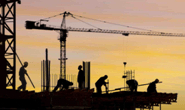Steel Products

SMU Steel Summit: Simonson Expects More Volatility in Construction
Written by David Schollaert
August 26, 2021
The shortage of qualified workers and supply chain disruptions continue to be a drag on the U.S. construction sector, said economist Ken Simonson, who predicted continued volatility for nonresidential building in the year ahead.
Speaking to the crowd of steel executives at SMU’s Steel Summit Tuesday in Atlanta, the Associated General Contractors of America’s chief economist said the construction outlook remains transitory. Shortages of construction materials should improve slowly. Nevertheless, the largest issues impacting the construction sector which relate directly to bottlenecks on transport and delivery, should continue to constrain the construction industry for the balance of the year.
“The pressure on materials costs are significant and are slowing or halting projects,” said Simonson. “Still, it should not spread onto consumers or wage costs. The current construction environment should remain impacted primarily by supply disruptions over employment disruptions.”
Simonson detailed how construction employment has plunged by 15% since February 2020, almost at the same rate as the total non-farm payroll. The construction industry bounced back last May and residential construction continued rising through the balance of the year. But nonresidential construction stalled suddenly last spring, and has only added about 1% from the June 2020 level.
Construction has varied widely from region to region. The largest metro areas have seen some of the greatest disruptions and have been, at times, the slowest to recover.
Through the first five months of 2021, construction spending rose 5% when compared to the same 2020 period. The differences across sectors are significant. Private residential spending has risen by more than 20%, while private and public nonresidential spending have declined by nearly 9% during the same period.
AGC expects further volatility across the construction sector due to supply scarcity. Materials cost and availability remain the greatest concern for contractors. Price points for construction materials are expected to remain elevated with further increases likely. However, the impact of high prices will mostly be felt by delayed projects.
On a positive note, Simonson said the downtrend in nonresidential construction is likely nearing the bottom. Future building plans and projects, according to the Architecture Billings Index, point towards an increase in spending and project commencement over the next 9-12 months.
“Barring any major COVID setbacks, the economy should see some normalization,” said Simonson. “The pending infrastructure spend will certainly aid in the correction.”
By David Schollaert, David@SteelMarketUpdate.com

David Schollaert
Read more from David SchollaertLatest in Steel Products

Final Thoughts
The difference: The spat with Turkey was a big deal for steel. This time, the 50% reciprocal tariff for Brazil – if it goes into effect as threatened on Aug.1 – hits everything from coffee and to pig iron. It seems almost custom-built to inflict as much pain as possible on Brazil.

CRU: US rebar and wire rod prices rise alongside S232 increase
CRU Senior Steel Analyst Alexandra Anderson discusses current market and pricing dynamics for long steel products in the US.
CRU: Excessive global supply could hit rebar mill investments in US
Following the onset of the war in Ukraine in March 2022, concerns about import availability and expectations of rising demand from President Biden’s Infrastructure Bill pushed US rebar prices to record highs. In response, a flurry of new mills and capacity expansions were announced to meet the rise in demand from growth in the construction […]

Steel buyer spirits tempered by soft spot market conditions
Steel sheet buyers report feeling bogged down by the ongoing stresses of stagnant demand, news fatigue, tariff negotiations or implementation timelines, and persistent macroeconomic uncertainty.

CRU: US stainless prices to rise on expanded S232 tariffs
Stainless prices in the US market will rise, following price increases by major US producers. Our base case scenario incorporates higher US prices in the near term, despite the initial negative reaction by the market. US stainless prices will go up in 2025 H2 and will stay elevated in 2026 as tariffs on stainless […]
